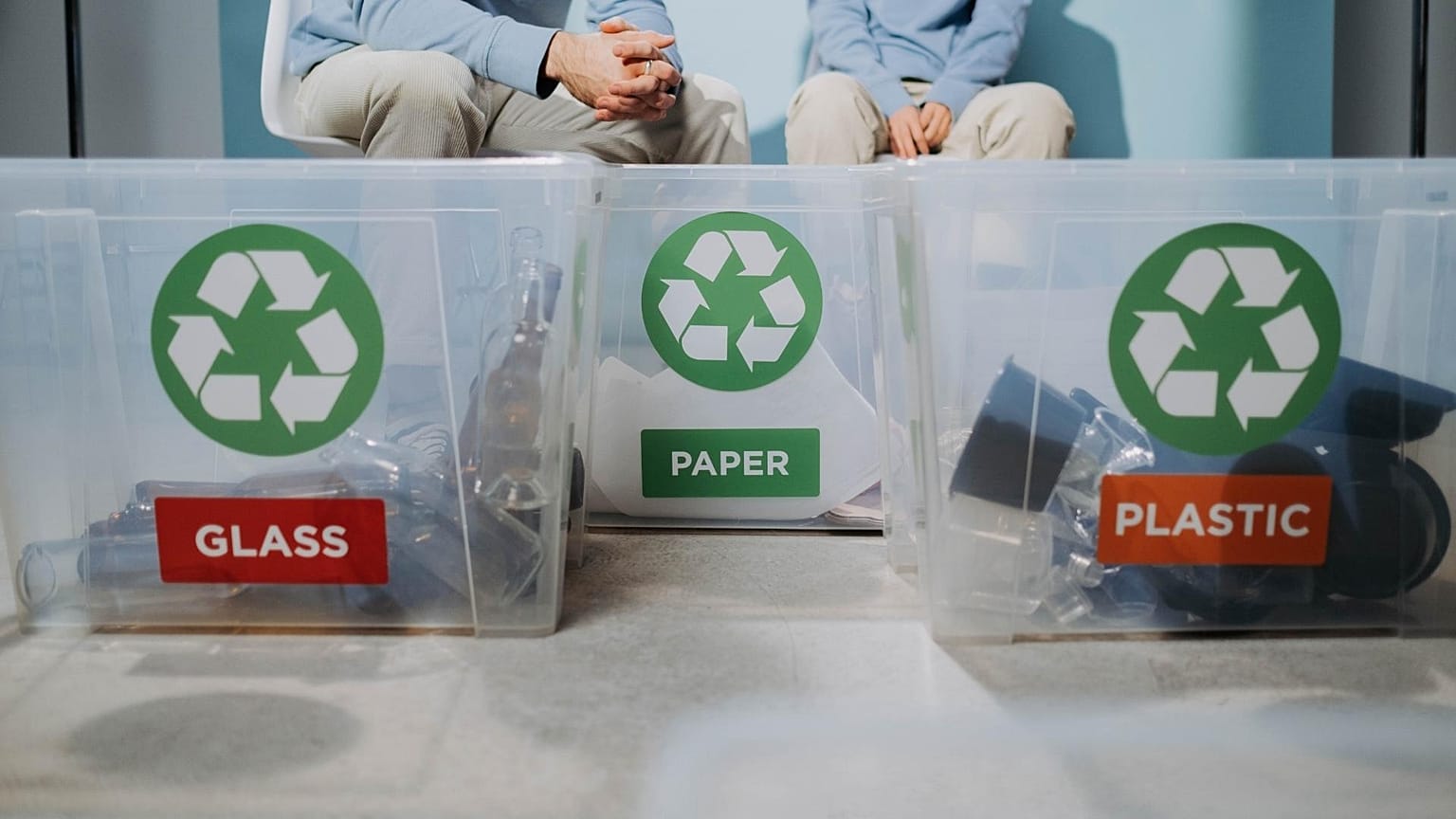EU countries have significantly increased their recycling rates, but the speed of this progress is slowing down, experts warn.
The average EU citizen generated 4.8 tonnes of waste in 2020 - but only 38 per cent of it was recycled. In some member states, more than 60 per cent of household waste still goes to landfill.
Recycling our rubbish is a crucial way to reduce the consumption of primary resources by replacing them with secondary materials which have already been used at least once.
As Europe aims for a fully circular economy, how are individual countries doing on waste management? How much waste is generated and recycled per inhabitant in Europe? And which European countries recycle the most?
It’s tricky to sift through the piles of data for answers, but pinning down different definitions helps us to weigh up Europe's waste challenges.
Households produce only 9 per cent of total waste
In 2020, the total waste generated in the EU by all economic activities and households amounted to 2,154 million metric tonnes. That is 4,815 kg per person.
Households generated only 9.4 per cent of this trash total.
Construction (37.5 per cent) and mining and quarrying (23.4 per cent) are largely responsible for the waste produced, generating over 60 per cent of total waste in the EU.
Waste and water services made up 10.8 per cent, and manufacturing accounted for 10.6 per cent.
Germany and France generate a third of the EU’s waste
Germany (401 million tonnes) and France (310 million tonnes) contributed the most to the total amount of waste produced in the EU. As of 2020, these two countries were responsible for one-third of the EU’s waste at 19 and 14 per cent respectively.
The UK (282 million tonnes), a former member of the bloc, produced the third highest amount of waste, followed by Italy (175 million tonnes) and Poland (170 million tonnes).
As mining waste is one of the largest waste streams in the EU, excluding this enables us to more easily compare countries according to Eurostat, the EU’s official statistics office.
How much waste is generated by each person in the EU?
In 2020, an equivalent of 4.8 tonnes of waste was produced per EU inhabitant.
This figure includes 3,080 kg of major mineral waste and 1,735 kg of waste from other sources. In other words, 64 per cent of waste in the EU is down to mining, including waste rock and tailings (the leftover material from an ore).
Waste generated per person ranged from 1.5 tonnes in Croatia to 21 tonnes in Finland among EU member states, according to the latest figures.
Bulgaria (16.8 tonnes) and Sweden (14.7 tonnes) followed Finland. The figures in Germany and France were very close to the EU average of 4.8 tonnes.
Waste treatment: Recovery or disposal?
In 2020, 1,971 million tonnes of waste were treated in the EU. Since this figure excludes exports and includes imports, it’s not directly comparable to the amount of waste generated in the bloc.
Waste treatment is divided into two main categories: recovery and disposal. Recovery includes recycling, energy recovery and backfilling - where waste is used to restructure excavated areas like gravel pits and underground mines. Disposal covers landfill and incineration.
Eurostat found that 39.9 per cent of the waste treated was recycled, 12 per cent was backfilled and the share of energy recovery was 6.5 per cent.
In the EU, the share of waste treatment increased from 45.9 per cent in 2004 to 59.1 per cent in 2020. While the share of disposal fell from 54.1 per cent to 40.9 per cent in the same period.
The EU’s recycling rate is around 40 per cent
In 2020, the share of recycling in total waste treatment was 39.9 per cent in the EU. The recycling rate varied considerably from 5.2 per cent in Romania to 83.2 per cent in Italy.
The recycling rate was higher than the EU average in France (54.2 per cent) and Germany (44 per cent), the two leading countries in terms of the highest amounts of waste generated.
The share of recycling in total waste treatment was considerably lower in Finland (9.5 per cent), where the waste generated per capita was highest among all EU member states. This figure was also low in neighbouring Sweden (11.9 per cent).
The Eurostat dataset doesn’t include the UK, but according to the Office for National Statistics, the share of “recycling and other recovery” was 50.4 per cent in the UK in 2018. Backfilling (6.6 per cent) is not included in that figure.
Why are European countries’ recycling records so different?
The main reason for the huge contrast in the share of recycling is down to the economic activities that generate waste.
In 2020, the share of mining and quarrying in total waste was 75 per cent in Finland, 77 per cent in Sweden and 84 per cent in Romania.
Some of the EU’s greatest known reserves of minerals used for batteries and other products are located in Finland where there are around 40 operational mines producing nickel, zinc, lithium, cobalt and gold among others.
Half of municipal waste is recycled in the EU
What about households’ roles in waste management? They generated only 9.4 per cent of total waste in the EU. Municipal waste statistics give us some insight into household and office waste, as well as the composition of household waste.
In 2021, almost half (49.6 per cent) of municipal waste was recycled in the EU.
Germany had the highest recycling rate for municipal waste.
In 2021, the recycling rate of this rubbish stream varied from 11.3 per cent in Romania to 71.1 per cent in Germany.
Besides Germany, six other EU nations had higher recycling rates than the EU average: Austria, Slovenia, the Netherlands, Luxembourg, Belgium and Italy.
France, the UK and Scandinavian countries have lower recycling rates than average.
The recycling rate of municipal waste was 45.1 per cent in France and 44.1 per cent in the UK (2018 data). Remarkably, this figure was lower than the EU average in four Scandinavian countries: Sweden (39.5), Norway (38.2 per cent), Finland (37.1 per cent) and Denmark (34.3 per cent).
Recycling rates have declined in Norway and Denmark
The recycling rate of municipal waste between 2001 and 2021 rose by 21 per cent in the EU.
However, the European Environment Agency (EEA) warns that the rate of progress has been slowing down in recent years.
Slovenia had the highest rise in its recycling rate in the last two decades at 57 per cent. Most EU countries significantly increased their recycling rates of municipal waste in this period.
However, rates fell by 6 per cent in Norway, 2 per cent in Denmark and 1 per cent in Austria.
Why are some countries better at recycling than others?
According to the EEA, countries that perform better in terms of recycling have wider ranges of measures in place compared to those with lower recycling rates.
These include landfill bans on biodegradable waste or non-pretreated municipal waste, and mandatory separate collection of municipal waste types, especially biowastes.
Top countries also have economic instruments such as landfill and incineration taxes, and waste collection fees that strongly encourage recycling.
The EEA also found that high levels of national environmental awareness contributed to high recycling rates in addition to the effective roll-out of national waste management legislation.
The EU also exports some of its waste
No picture of EU waste is complete without looking at how much is ejected from the frame.
In 2021, exports of waste from the EU to non-EU countries reached 33 million tonnes, an increase of 77 per cent since 2004.
Imports of waste from non-EU countries increased by 11 per cent in this period, amounting to 19.7 million tonnes in 2021.
Turkey was the largest destination for waste exported from the EU, with a volume of around 14.7 million tonnes in 2021, almost half (45 per cent) of total exports. This amount was more than three times as much as in 2004.
Which EU countries export the most waste?
The Netherlands exported 6.4 million tonnes of waste to non-EU countries, followed by Belgium (4.3 million tonnes) and Germany (3.5 million tonnes).
The Netherlands has the largest transit port for plastic waste.
UK waste exports to the Netherlands increased by more than 60 per cent between 2020 and 2021, according to Dutch charity Plastic Soup Foundation.
Over the same period, Dutch plastic exports to Latin America, Asia and Africa more than doubled, leading green campaigners to denounce waste being dumped abroad by Dutch middlemen.


















